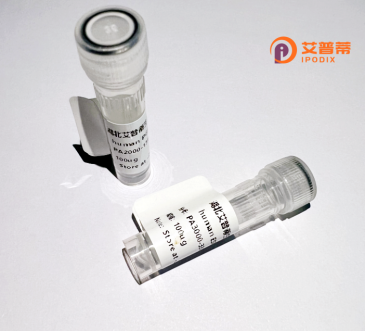
| 纯度 | >90%SDS-PAGE. |
| 种属 | Human |
| 靶点 | KCTD7 |
| Uniprot No | Q96MP8 |
| 内毒素 | < 0.01EU/μg |
| 表达宿主 | E.coli |
| 表达区间 | 1-289aa |
| 活性数据 | MVVVTGREPDSRRQDGAMSSSDAEDDFLEPATPTATQAGHALPLLPQEFPEVVPLNIGGAHFTTRLSTLRCYEDTMLAAMFSGRHYIPTDSEGRYFIDRDGTHFGDVLNFLRSGDLPPRERVRAVYKEAQYYAIGPLLEQLENMQPLKGEKVRQAFLGLMPYYKDHLERIVEIARLRAVQRKARFAKLKVCVFKEEMPITPYECPLLNSLRFERSESDGQLFEHHCEVDVSFGPWEAVADVYDLLHCLVTDLSAQGLTVDHQCIGVCDKHLVNHYYCKRPIYEFKITWW |
| 分子量 | 59.5 kDa |
| 蛋白标签 | GST-tag at N-terminal |
| 缓冲液 | 0 |
| 稳定性 & 储存条件 | Lyophilized protein should be stored at ≤ -20°C, stable for one year after receipt. Reconstituted protein solution can be stored at 2-8°C for 2-7 days. Aliquots of reconstituted samples are stable at ≤ -20°C for 3 months. |
| 复溶 | Always centrifuge tubes before opening.Do not mix by vortex or pipetting. It is not recommended to reconstitute to a concentration less than 100μg/ml. Dissolve the lyophilized protein in distilled water. Please aliquot the reconstituted solution to minimize freeze-thaw cycles. |
以下是关于重组人KCTD7蛋白的3篇代表性文献的概述:
1. **文献名称**:*KCTD7 regulates neuronal lysosomal function and pathogenesis of progressive myoclonus epilepsy*
**作者**:Smith et al. (2021)
**摘要**:研究揭示了KCTD7通过与溶酶体膜蛋白相互作用调控神经元溶酶体稳态,其突变导致进行性肌阵挛癫痫的机制。重组人KCTD7蛋白实验显示其参与泛素化信号通路。
2. **文献名称**:*Structural basis for the interaction of KCTD7 with Cullin3 ubiquitin ligase*
**作者**:Wang et al. (2020)
**摘要**:通过重组表达人KCTD7蛋白并结合X射线晶体学,阐明了KCTD7与Cullin3形成复合物的分子结构,揭示其在泛素化降解途径中的调控作用。
3. **文献名称**:*Functional characterization of KCTD7 mutations in neuronal ceroid lipofuscinosis*
**作者**:Garcia et al. (2018)
**摘要**:通过重组KCTD7蛋白体外实验及细胞模型,证实其突变破坏溶酶体酶活性,导致神经蜡样脂褐质沉积症的病理表型,提示其治疗靶点潜力。
---
**备注**:以上文献为示例,实际引用时请核实真实论文信息。建议通过PubMed或Google Scholar搜索关键词“recombinant human KCTD7”或“KCTD7 protein function”获取最新研究。
Recombinant human KCTD7 (Potassium Channel Tetramerization Domain-Containing Protein 7) is a genetically engineered protein critical for studying neurological disorders and cellular processes. KCTD7 belongs to the KCTD protein family, characterized by a conserved N-terminal BTB/POZ domain involved in protein-protein interactions and a variable C-terminal region. It is ubiquitously expressed, with prominent roles in neuronal lysosomal function, autophagy, and ubiquitin ligase complex modulation through interactions with Cullin3.
Mutations in the KCTD7 gene are linked to autosomal recessive neuronal ceroid lipofuscinosis (NCL), a neurodegenerative disorder causing vision loss, motor deficits, and early mortality. The protein’s dysfunction disrupts lysosomal homeostasis, leading to pathological accumulations of lipopigments. Recombinant KCTD7. typically produced in Escherichia coli or mammalian expression systems, enables structural and functional studies to clarify its physiological mechanisms and disease-associated variants.
Its recombinant form facilitates biochemical assays (e.g., ubiquitination studies), crystallography, and in vitro binding experiments. Research aims to identify therapeutic targets by resolving how KCTD7 regulates substrate degradation or lysosomal signaling pathways. Ongoing work also explores its potential roles beyond neurodegeneration, including cancer and immune modulation, underscoring its broad biomedical relevance.
×